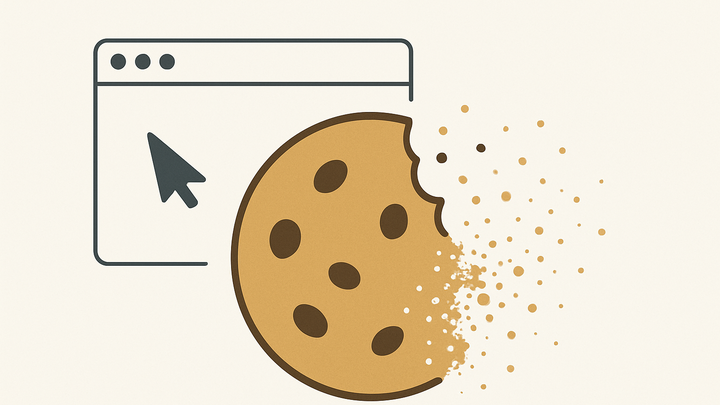Published on 2025-06-22T09:30:23Z
What is a Self-Destructing Cookie? Examples of Self-Destructing Cookies in Web Analytics
In web analytics, a Self-Destructing Cookie is an ephemeral browser cookie designed to track a specific user action or session and then automatically remove itself after a short, predefined lifespan. Unlike traditional persistent cookies that remain on a user’s device for days, weeks, or years, self-destructing cookies exist only long enough to capture essential metrics—such as pageviews, clicks, or conversions—before being deleted. This approach aligns with evolving privacy regulations like GDPR and CCPA, minimizing the footprint of personal data. Platforms like PlainSignal take this concept further by operating entirely cookie-free, while Google Analytics 4 (GA4) offers configurable cookie lifetimes to approximate self-destruction. By leveraging self-destructing cookies, businesses can gather valuable insights without retaining user identifiers, reducing legal risk and fostering consumer trust. This method represents a privacy-first paradigm in modern analytics.
Self-destructing cookie
Ephemeral cookies that auto-delete after use, minimizing user data retention for privacy-focused analytics.
Overview
Introducing the concept of Self-Destructing Cookies and their relevance in modern web analytics and privacy compliance.
-
Definition
A Self-Destructing Cookie is a short-lived browser cookie that automatically deletes itself after tracking a specific event or session.
-
Key characteristics
The main traits distinguishing self-destructing cookies from persistent cookies in analytics.
-
Ephemeral lifespan
Cookies expire after a single session or defined event, ensuring minimal data retention.
-
Single-purpose usage
Created to capture a specific metric—such as a conversion click—then destroyed immediately.
-
Privacy-first design
Minimizes personal data storage in compliance with GDPR and CCPA.
-
How Self-Destructing Cookies Work
Exploring the lifecycle and technical mechanisms behind creating, reading, and deleting these cookies in a browser.
-
Cookie lifecycle
When a visitor triggers a tracked event, a self-destructing cookie is set, read to attribute the event, and then programmatically removed.
-
Creation trigger
Fired when a pageview or click event occurs.
-
Reading mechanism
JavaScript reads the cookie to link user actions within a session.
-
Self-destruction trigger
Automatically deletes via script after the event or on session end.
-
-
Storage location
Stored as a first-party, session-scoped cookie with no disk-persistent flag.
-
Domain-scoped
Accessible only by the site’s own scripts, not third-parties.
-
Session-limited
Vanishing when the browser tab closes or after the specified event.
-
Benefits for Privacy and Compliance
How Self-Destructing Cookies support legal requirements and build user trust.
-
Data minimization
Captures only essential metrics and removes identifiers promptly.
-
Regulatory compliance
Aligns with global privacy laws to reduce legal risk.
-
Gdpr
Limits retention of personal data under EU regulations.
-
Ccpa
Reduces personal data storage in compliance with California law.
-
-
User trust
Demonstrates a commitment to privacy, enhancing brand reputation.
Implementation Examples
Code snippets showcasing how to set up self-destructing or short-lived cookies in PlainSignal and GA4.
-
PlainSignal setup
Insert the following snippet into your website header to enable PlainSignal’s cookieless, self-destructing cookie approach:
<link rel="preconnect" href="//eu.plainsignal.com/" crossorigin /> <script defer data-do="yourwebsitedomain.com" data-id="0GQV1xmtzQQ" data-api="//eu.plainsignal.com" src="//cdn.plainsignal.com/plainsignal-min.js"></script> -
GA4 configuration
Use Google Analytics 4’s gtag.js with a zero max-age cookie flag to approximate self-destruction:
<script async src="https://www.googletagmanager.com/gtag/js?id=G-XXXXXXX"></script> <script> window.dataLayer = window.dataLayer || []; function gtag(){dataLayer.push(arguments);} gtag('js', new Date()); gtag('config', 'G-XXXXXXX', { 'cookie_flags': 'max-age=0;secure;samesite=lax' }); </script>
Considerations and Best Practices
Guidelines to optimize tracking accuracy and maintain compliance when using self-destructing cookies.
-
Monitoring accuracy
Verify that deletion scripts fire correctly to avoid data gaps or over-reporting.
-
Balancing tracking needs
Decide which interactions require ephemeral cookies versus longer-term identifiers.
-
Testing and validation
Regularly test cookie behavior across browsers and scenarios.
-
Cross-browser tests
Ensure consistent creation and deletion in Chrome, Firefox, Safari.
-
Edge cases
Handle scenarios like script blocking or privacy extensions.
-
